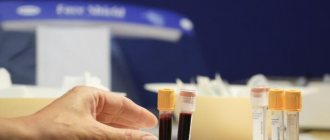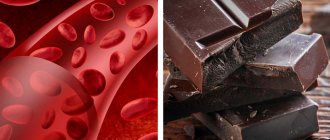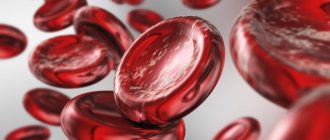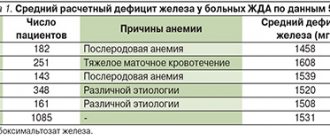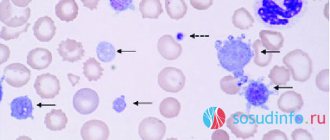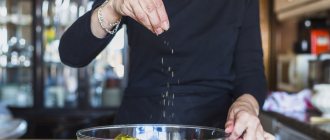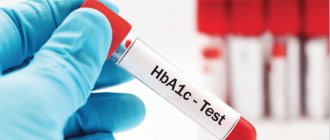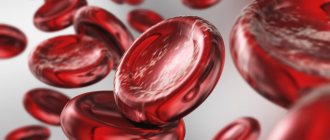General rules
The overwhelming number of diseases of the hematopoietic system occur with anemia , in which there is a decrease in the amount of hemoglobin per unit volume of blood, mainly with a simultaneous decrease in the total volume of red blood cells (or their number).
Anemia is one of the symptoms of various diseases or pathological conditions. Among the large set of anemias in clinical practice, the most common (up to 85% of cases) are anemia caused by a lack of iron in the body. This condition causes a disruption in the synthesis of iron-containing proteins, as a result of which oxygen deficiency develops in the body and the processes of cellular respiration are inhibited with the development of dystrophy in the organs and tissues of the body and disruption of their functions.
Other types of anemia : vitamin B12 deficiency anemia , folate deficiency anemia , hemolytic , sickle cell anemia are less common, but are also accompanied by similar symptoms.
The level of plasma iron is determined by the processes of synthesis and breakdown of red blood cells. The human body contains on average 3 to 5 g of iron in bound form. In the process of hematopoiesis, iron is used from the blood depot. Iron losses in the body are replenished with iron contained in food. Therefore, the nutritional factor is the leading factor in the development of iron deficiency anemia. However, iron from food is only absorbed by 10–20%, that is, the amount of iron consumed from food should be 5–10 times the daily requirement, which averages 10 mg/day for men with a loss level of about 1 mg/day and 18 mg/day for women with a loss level of up to 2 mg/day. Iron loss in urine, feces, sweat, hair and nails.
If there is insufficient intake of iron into the body from outside, the iron depot . Those at high risk of developing anemia include women of childbearing age, elderly people and children (due to their high need for iron) and all people who do not consume enough iron-containing foods (particularly vegetarians).
The main objectives of therapeutic nutrition for iron deficiency anemia are:
- Providing the body with physiologically complete nutrition with a sufficient amount of iron for the process of hematopoiesis.
- Balance the intake of substances that enhance and inhibit iron absorption.
- Balance the content of heme (found in products of animal origin, part of hemoglobin) and non-heme (found in plant products ionic in the form of 2-3 valent iron) iron compounds in food, taking into account the iron content in products and the degree of digestibility of iron from them.
- Select and balance foods with low hemoglobin that provide sufficient calorie intake and the optimal content of proteins, fats, and carbohydrates in food.
Fried liver
Animal products high in iron (in mg/100 g of product) include:
- calf liver (7.9);
- beef liver (7.1);
- pork liver (22.1);
- chicken liver (17.5);
- oysters (9.2);
- beef kidneys (10.0);
- blood sausage (6.4);
- liverwurst (5.3);
- various types of meat (2.0–3.6);
- mussels (5.1);
- chicken yolk (6.7);
- beef tongue (4.1).
Products of plant origin that are leaders in iron content:
- wheat bran (11.0);
- flax seed (8.2);
- sesame (10.0);
- pistachios (3.7);
- soybean (9.7);
- oat flakes (4.6);
- buckwheat (6.2);
- spinach (2.7);
- peanuts (4.5).
Products that increase hemoglobin levels in the blood should be included in every meal.
The diet for low hemoglobin is based on dietary Table No. 11 (option with a high protein content). The energy value of the diet is 3200-3400 Kcal (120 g of proteins, of which 60% are animal proteins; fats - 90-100 g with the inclusion of at least 25% vegetable fats, carbohydrates -450 g; sodium chloride content - 12-15 g , free liquid - 1.5 -2.0 liters).
To increase hemoglobin, the following are introduced into the diet:
- various meat by-products, fish products (herring, balyk, caviar);
- canned food - sprats, sardines, etc.;
- non-fish seafood;
- vegetable oil and butter;
- full range of dairy products;
- chicken eggs;
- various cereals;
- vegetables fruits;
- honey;
- beverages.
Particular attention is paid to the issue of iron digestibility. of vitamin C and copper in your diet ascorbic acid to the diet increases the absorption of iron, since ascorbic acid takes an active part in the process of iron absorption. Adding juice from citrus fruits increases the absorption of iron from bread, cereals, and eggs.
Foods rich in copper include: apricots, cherries, dried figs, brown algae, seaweed, green vegetables. In order to improve the absorption of iron, iron oxide and ferrous sulfate , iron glycerophosphate and gluconate .
Iron absorption is suppressed by strong tea and foods rich in tannins. Chocolate, egg yolk, cocoa, as well as foods rich in vitamin D (dairy products), which should be limited in the diet, worsen the process of iron absorption. To reduce their negative effects, it is recommended to consume them separately from other products.
Almost all types of culinary processing of foods are allowed (baking, stewing, boiling, steaming), except for frying, since this process produces oxidation products that negatively affect the body, and also uses a lot of fat, which is contraindicated for anemia. The food temperature is standard (15-60 degrees Celsius).
For B12-deficiency anemia, the diet includes foods that are the main sources of vitamin B12 (per 100 mg of product): beef liver - 60 mcg; chicken liver - 16 mcg; pork liver - 30 mcg; beef - 2.6 mcg; mackerel - 12 mcg; rabbit meat - 4.3 mcg; pork - 2 mcg; cod - 1.6 mcg; carp - 1.5 mcg; chicken egg - 0.5 mcg.
For folate deficiency anemia (lack of vitamin B9 ), the diet includes foods containing a lot of folic acid, both animal and plant origin: liver, pork, beef, poultry, fish, lamb, eggs, milk and dairy products, legumes, wheat yeast and sprouts, buckwheat and oatmeal, bran, cereals, green leafy vegetables, nuts, yeast, apricots, pumpkin, mushrooms, beets, bananas, melon, dates, bread.
Diso Nutrimun for anemia
With anemia, it is important to take care of both the quantity of protein and its quality. The most useful protein will be one that is highly bioavailable. In addition, it is fundamentally important that protein products do not contain animal fats and other components that reduce the absorption of iron.
Traditional food products containing complete animal proteins, unfortunately, do not fully meet these requirements. Therefore, including the Diso Nutrimun protein mixture in dishes is an ideal solution for getting protein that is beneficial for anemia.
What is Nutrimun?
Nutrimun protein mixture contains concentrated milk proteins, which have the highest biological value and are easily digestible. Nutrimun protein is balanced in amino acid composition, which makes its biological value the highest.
Nutrimun protein mixture is a real help in providing the body with protein in case of many digestive disorders, when you have to follow a special restrictive diet, eat frequently and in small portions.
How does he help?
Nutrimun is a protein that can be easily digested even with a lack of digestive enzymes, will also be easily absorbed by the body and will bring maximum benefit. Use Nutrimun along with traditional foods in the diet prescribed by your doctor, add it to any food and drink.
Nutrimun, as an additional source of complete protein, will definitely help speed up your recovery and restore impaired functions. Diso Nutrimun does not contain saturated animal fats or substances that reduce iron absorption, which distinguishes it from other protein products.
Authorized Products
Nutrition for low hemoglobin is based on the inclusion in the diet of foods containing the maximum amount of iron: internal organs and offal (beef and chicken liver, chicken stomachs and hearts, beef tongue), red meat (beef), meat products (ham, sausage, frankfurters), fish and fish products (caviar, balyk, sprats, sardines), seafood (mussels, shrimp, squid), butter and vegetable oil.
As for dairy products, it is useful to include cheeses, cottage cheese, and fermented milk products in your diet. Soups and all first courses are prepared in strong meat or fish broth. To prepare a side dish with a low iron content, you can use almost all types of cereals, legumes and pasta.
It is recommended to include sufficient quantities of wheat/rye bread and flour products (bakery, baked pies, biscuits) in the diet. All vegetables and fruits are allowed in any culinary processing; it is especially important to include in the diet fruits and vegetables with a high content of ascorbic acid (citrus fruits, rose hips, chokeberries, black currants). The diet should contain various dried fruits - dried apricots, raisins, prunes, figs; seeds and nuts - almonds, pistachios, peanuts, cashews, walnuts, sunflower seeds, pumpkin.
Vegetable and leafy salads are very healthy. Therapeutic nutrition involves the inclusion of sweet foods and dishes made from them (honey, jams, preserves) into the diet. Honey is especially useful. The fructose it contains promotes the absorption of iron in the intestines. It is preferable to consume dark varieties of honey as they contain more copper, iron and manganese. If acidity is low, honey is consumed immediately before meals, and if acidity is high, honey should be consumed 1.5 hours before meals. In the absence of contraindications, you are allowed to eat up to 50 g of honey per day. As for drinks, be sure to include in your diet a decoction of wheat bran and rose hips, vegetable and fruit juices, especially beet juice.
Table of permitted products
| Proteins, g | Fats, g | Carbohydrates, g | Calories, kcal | |
Vegetables and greens | ||||
| boiled cauliflower | 1,8 | 0,3 | 4,0 | 29 |
| boiled potatoes | 2,0 | 0,4 | 16,7 | 82 |
| boiled carrots | 0,8 | 0,3 | 5,0 | 25 |
| salad pepper | 1,3 | 0,0 | 5,3 | 27 |
| boiled beets | 1,8 | 0,0 | 10,8 | 49 |
| dill | 2,5 | 0,5 | 6,3 | 38 |
Fruits | ||||
| apricots | 0,9 | 0,1 | 10,8 | 41 |
| oranges | 0,9 | 0,2 | 8,1 | 36 |
| cherry | 0,8 | 0,5 | 11,3 | 52 |
| grapefruit | 0,7 | 0,2 | 6,5 | 29 |
Berries | ||||
| cranberry | 0,5 | 0,0 | 6,8 | 26 |
| gooseberry | 0,7 | 0,2 | 12,0 | 43 |
| Rowan | 1,5 | 0,1 | 10,9 | 50 |
| currant | 1,0 | 0,4 | 7,5 | 43 |
| rose hip | 1,6 | 0,0 | 14,0 | 51 |
Nuts and dried fruits | ||||
| nuts | 15,0 | 40,0 | 20,0 | 500 |
| prunes | 2,3 | 0,7 | 57,5 | 231 |
Cereals and porridges | ||||
| buckwheat (kernel) | 12,6 | 3,3 | 62,1 | 313 |
| oat groats | 12,3 | 6,1 | 59,5 | 342 |
| cereals | 11,9 | 7,2 | 69,3 | 366 |
| Wheat groats | 11,5 | 1,3 | 62,0 | 316 |
| wheat bran | 15,1 | 3,8 | 53,6 | 296 |
Bakery products | ||||
| wheat bread | 8,1 | 1,0 | 48,8 | 242 |
| whole grain bread | 10,1 | 2,3 | 57,1 | 295 |
Confectionery | ||||
| jam | 0,3 | 0,1 | 56,0 | 238 |
Raw materials and seasonings | ||||
| honey | 0,8 | 0,0 | 81,5 | 329 |
Dairy | ||||
| condensed milk | 7,2 | 8,5 | 56,0 | 320 |
| kefir 3.2% | 2,8 | 3,2 | 4,1 | 56 |
| cream 15% (low fat) | 2,3 | 15,0 | 3,6 | 161 |
| sour cream 15% (low fat) | 2,6 | 15,0 | 3,0 | 158 |
Cheeses and cottage cheese | ||||
| cheese | 24,1 | 29,5 | 0,3 | 363 |
| cottage cheese | 17,2 | 5,0 | 1,8 | 121 |
Meat products | ||||
| lean pork | 16,4 | 27,8 | 0,0 | 316 |
| pork liver | 18,8 | 3,6 | 0,0 | 108 |
| beef | 18,9 | 19,4 | 0,0 | 187 |
| beef liver | 17,4 | 3,1 | 0,0 | 98 |
| beef brains | 9,5 | 9,5 | 0,0 | 124 |
| calf liver | 19,2 | 3,3 | 4,1 | 124 |
| mutton | 15,6 | 16,3 | 0,0 | 209 |
| rabbit | 21,0 | 8,0 | 0,0 | 156 |
| ham | 22,6 | 20,9 | 0,0 | 279 |
| liver pate | 11,6 | 28,9 | 2,5 | 317 |
| beef stew | 14,1 | 17,4 | 0,0 | 214 |
Sausages | ||||
| smoked sausage | 16,2 | 44,6 | 0,0 | 466 |
| blood sausage | 9,0 | 19,5 | 14,5 | 274 |
| beef sausages | 11,4 | 18,2 | 1,5 | 215 |
Bird | ||||
| chicken liver | 20,4 | 5,9 | 1,4 | 140 |
| turkey | 19,2 | 0,7 | 0,0 | 84 |
| turkey liver | 19,5 | 22,0 | 0,0 | 276 |
| goose liver | 15,2 | 39,0 | 0,0 | 412 |
Eggs | ||||
| chicken eggs | 12,7 | 10,9 | 0,7 | 157 |
Fish and seafood | ||||
| brown algae | 1,7 | 0,6 | 8,3 | 43 |
| pink salmon | 20,5 | 6,5 | 0,0 | 142 |
| Red caviar | 32,0 | 15,0 | 0,0 | 263 |
| cod roe | 24,0 | 0,2 | 0,0 | 115 |
| pike caviar | 17,3 | 2,0 | 0,0 | 87 |
| squid | 21,2 | 2,8 | 2,0 | 122 |
| shrimps | 22,0 | 1,0 | 0,0 | 97 |
| salmon | 19,8 | 6,3 | 0,0 | 142 |
| mussels | 9,1 | 1,5 | 0,0 | 50 |
| seaweed | 0,8 | 5,1 | 0,0 | 49 |
| herring | 16,3 | 10,7 | — | 161 |
| cod (liver in oil) | 4,2 | 65,7 | 1,2 | 613 |
| trout | 19,2 | 2,1 | — | 97 |
Oils and fats | ||||
| vegetable oil | 0,0 | 99,0 | 0,0 | 899 |
| butter | 0,5 | 82,5 | 0,8 | 748 |
| olive oil | 0,0 | 99,8 | 0,0 | 898 |
| * data is per 100 g of product | ||||
Fully or partially limited products
Excluded from the diet are very fatty meats, fish and poultry, culinary, beef and lamb fat, spices, fatty and very hot sauces, pastries and cakes with a large content of cream.
Limit foods high in calcium (milk and dairy products, parsley), tannin and caffeine (coffee, strong tea, chocolate, Coca-Cola), as they interfere with the absorption of iron.
Drinking alcohol in case of iron deficiency anemia is completely excluded, since ethyl alcohol negatively affects the liver and disrupts the absorption of iron and flavocins .
Table of prohibited products
| Proteins, g | Fats, g | Carbohydrates, g | Calories, kcal | |
| cake | 3,8 | 22,6 | 47,0 | 397 |
| chocolate | 5,4 | 35,3 | 56,5 | 544 |
| mayonnaise | 2,4 | 67,0 | 3,9 | 627 |
| sour cream 30% | 2,4 | 30,0 | 3,1 | 294 |
| pork fat | 1,4 | 92,8 | 0,0 | 841 |
| rendered beef fat | 0,0 | 99,7 | 0,0 | 897 |
| cooking fat | 0,0 | 99,7 | 0,0 | 897 |
| rendered pork fat | 0,0 | 99,6 | 0,0 | 896 |
| white dessert wine 16% | 0,5 | 0,0 | 16,0 | 153 |
| dry red wine | 0,2 | 0,0 | 0,3 | 68 |
| vodka | 0,0 | 0,0 | 0,1 | 235 |
| cognac | 0,0 | 0,0 | 0,1 | 239 |
| liquor | 0,3 | 1,1 | 17,2 | 242 |
| beer | 0,3 | 0,0 | 4,6 | 42 |
| cola | 0,0 | 0,0 | 10,4 | 42 |
| coffee | 0,2 | 0,0 | 0,3 | 2 |
| Pepsi | 0,0 | 0,0 | 8,7 | 38 |
| black tea | 20,0 | 5,1 | 6,9 | 152 |
| energy drink | 0,0 | 0,0 | 11,3 | 45 |
| * data is per 100 g of product | ||||
Diet rules to increase its level
You should take the most responsible approach to planning your own diet.
Firstly , you should exclude fast food and the consumption of so-called junk food, unhealthy food with a high fat content, the presence of preservatives and flavor enhancers, which can cause diabetes.
This food is not only harmful and interferes with weight loss, but also dulls the taste buds, making them immune to the taste of natural food.
Secondly , it is worth planning your meals for at least one week. It is necessary to plan in such a way that over the course of 7 days the body systematically receives all the substances it needs, vitamins, minerals, trace elements, etc.
Vitamins and minerals can be taken additionally in dosage form , but the degree of their absorption even among specialists raises serious suspicions. All the same substances can be obtained from food if you approach the issue properly. In addition, it is necessary to establish a diet regimen: you need to eat food every day at the same time, in different portions and taking into account the body’s need for various substances during the day.
It is recommended to coordinate the diet with the supervising general practitioner, nutritionist or dietician.
It is also necessary to avoid consuming foods that cause allergic reactions.
Comments from nutritionists
Quite often the question is asked: “How to increase hemoglobin for a vegetarian?”
Indeed, a certain problem exists, especially in cases where a person practices strict vegetarianism. Since the absorption of iron in the intestines is largely determined by the nature of the food and the calorie content of the daily diet, many vegetarians develop iron deficiency over time, since heme iron is absent in food products, and non-heme iron contained in cereals and vegetables has extremely low absorption. In addition, the higher fiber content of vegetarian foods interferes with the absorption of iron. Therefore, if your diet does not contain animal hematopoietic foods, you need to be especially attentive to your diet in order to sufficiently provide your body with iron.
It can be recommended to include in the diet a sufficient amount of foods rich in ascorbic acid , which significantly increases the absorption of iron. In order to prevent the development of anemia, you should periodically take iron-containing medications, for example, Ferro-Folgamm , which contains a balanced combination of anhydrous iron sulfate, folic acid , cyanocobalamin and ascorbic acid .
The importance of protein in anemia
The main cause of anemia is insufficient synthesis in the body of hemoglobin molecules that make up red blood cells - erythrocytes. Hemoglobin is a protein whose complex structure contains iron atoms. Therefore, a prerequisite for the formation of hemoglobin molecules is the presence in the body of these two components in sufficient quantities - protein and iron. Without each of them, hemoglobin simply will not have anything to “build” from.
Reviews and results
- “... I periodically go on this diet, because due to heavy periods my hemoglobin level is low. As a rule, after a month of dietary nutrition and taking iron supplements, everything returns to normal”;
- “... After a long stay on a mono-diet and the development of anemia, the doctor prescribed a therapeutic diet and said that although dietary nutrition for anemia is an important stage of treatment, it is not able to independently compensate for the iron deficiency in the body. Therefore, he prescribed iron tablets.”
How to notice that hemoglobin is low
There are a number of symptoms that indicate that these indicators have been reduced to a level where it becomes harmful to health. The first symptoms are:
- Sleep disturbance
- Dizziness appears
- The lips turn blue, and the skin, on the contrary, becomes too white
- Shortness of breath appears, even when walking short distances
- Severe fatigue sets in
- Leg cramps appear
- Heart rate increases.
All these symptoms indicate a problem that should be solved as soon as possible. If several symptoms occur at once, you should immediately consult a doctor and get tested. Then you need to start fixing the problem.
